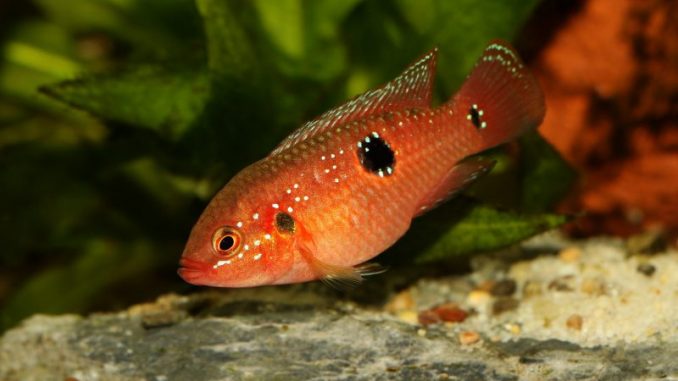
The jewel cichlid is a freshwater fish of the cichlid family. Jewel cichlids are colorful, medium-sized fish that have aggressive personalities and eat an omnivorous diet.
These African fish are popular among aquarists due to their beautiful iridescent coloring, despite their aggressive, territorial tendencies.
TABLE OF CONTENTS
Jewel Cichlid Facts & Overview
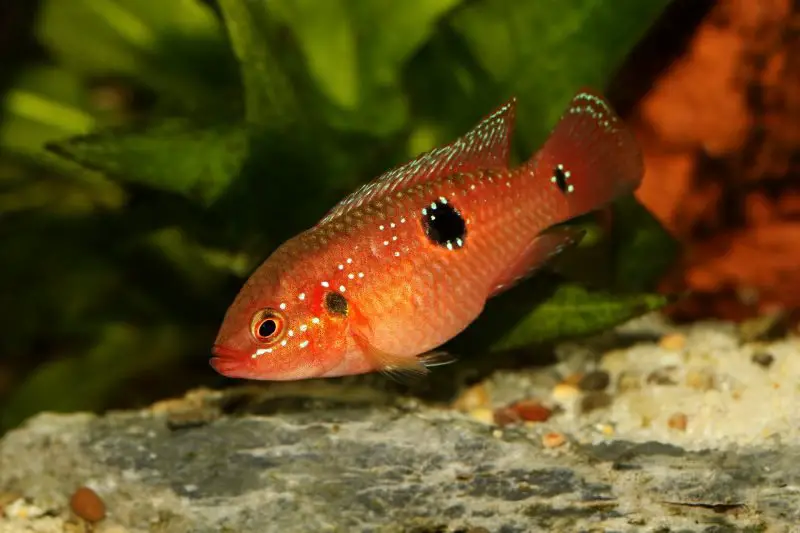
| Scientific name | Hemichromis bimaculatus |
| Common name | Jewel cichlid, African jewelfish, green jewel, blue jewel, jewel fish |
| Distribution | Lakes, rivers, and streams in West Africa |
| Size | 4–5.5 inches |
| Life expectancy | 5–7 years |
| Color | Blue, green, red, orange |
| Diet | Omnivore |
| Temperament | Aggressive |
| Minimum tank size | 30 gallons |
| Temperature | 75–80°F (22–26°C) |
| pH | 6.5–7.5 |
| Hardness | 4–16 dGH |
| Care level | Moderate |
| Breeding | Egg layer |
Origin
The jewel cichlid is native to the creaks, streams, rivers, lakes of West Africa. The fish’s freshwater natural habitat has varied water quality, and some fish are found in murky or brackish lagoons. Jewel cichlids prefer to live in waters that are sheltered by overhanging or floating vegetation, and swim close to the riverbed.
Adult Size & Lifespan
A full-grown jewel cichlid is 5.5 inches long. Some jewel cichlids grow much longer than this, to 12 inches or more. The fish are likely to grow larger in the wild, where they have more room and better nutrition. Male jewel cichlids are slimmer than females and up to 2 inches longer.
The average lifespan of a jewel cichlid is five years. Some fish live up to seven years in captivity, depending on the quality of care. Captive fish are likely to live longer than fish in the wild because fish in captivity are safe from potential predators.
Availability
Finding a jewel cichlid to purchase is easy. However, due to its aggressive nature, this species isn’t as popular as other African cichlids. The fish is more commonly available online than in local pet stores, and costs $8–$11 on average.
Reputable online stores selling jewel cichlids are:
Appearance & Behavior
The jewel cichlid has a medium-sized, attractive, sparkling body in shades of red, blue, and green. The fish is known for its aggressive, territorial behavior.
Colors, Patterns, Fins, and Sex Differences
Jewel cichlids have narrow, pointed bodies, large eyes, and upturned mouths. The fish are found in various colors, including red, purple, orange, green, and blue, and are iridescent, meaning that their scales sparkle under light. Some jewel cichlids have spots or stripes.
The African jewelfish has small anal fins that extend to the same spot as the dorsal fin, just before the caudal fin.
Male jewel cichlids are slimmer than females and have bolder colors, especially during breeding. Young jewel cichlids have a bump on their backs, which becomes less noticeable as the fish age. The fish lose their bright coloration when they’re stressed or sick.
Subspecies of jewel cichlid include blood-red jewel cichlids (with deep-red coloration), African jewelfish (which have red bodies with silvery-blue spots), and banded jewelfish (which have yellow-green coloration and five black patches on their sides).
Typical Behavior
Jewel cichlids are highly aggressive, territorial fish that prefer to live in single-species tanks with plenty of space to claim their own territories. The fish are fin-nippers and don’t get along well with most other fish species. Stress, cramped living conditions, and hunger are common causes of irritation and aggressive behavior in jewel cichlids.
Jewel cichlids are active fish that spend most of their time at the bottom of the tank, swimming quickly around the open space and digging in the substrate for food. The fish are diurnal, meaning they’re most active during the day.
Jewel Cichlid Tank Requirements
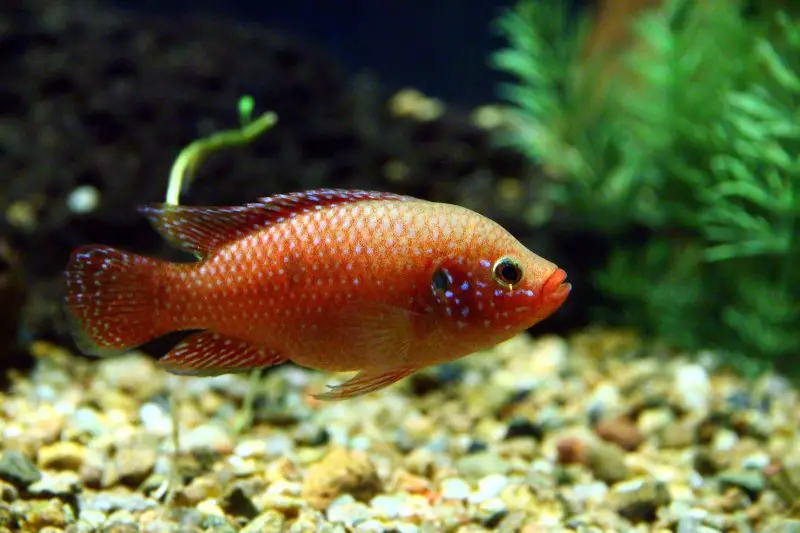
The jewel cichlid is moderately easy to care for. Although jewel cichlids have specific requirements for tank size and suitable tank mates, they’re hardy fish that can adapt to their surroundings as long as the water conditions are clean and warm.
Habitat and Tank Setup
The jewel cichlid’s natural habitat is slow-moving, warm freshwater lakes, rivers, and streams, often sheltered by vegetation. Provide a similar habitat in captivity with suitable water conditions and decorations.
The ideal tank size for a single jewel cichlid is 30 gallons. The more space you can provide for your fish, the less likely that the fish will develop aggressive behaviors due to stress.
Jewel cichlids are bottom dwellers, so your choice of substrate is important. Choose a sandy substrate that mimics the sandy riverbeds of the fish’s natural habitat. Avoid harsh or abrasive substrates, like gravel substrates, which could damage the fish’s scales while it digs for food.
Add large rocks, caves, and plants to provide shelter, territories, and hiding places for the cichlid. If you prefer live plants, choose hardy, deep-rooted plants that tolerate digging, like anubias, java fern, and Amazon sword. Otherwise, use artificial plants that can be attached to the bottom of the tank.
Tank Conditions
Ideal tank conditions for a jewel cichlid are:
| Water type | Warm, slow-moving freshwater |
| Tank size | Minimum 30 gallons for a single fish |
| Water temperature | 75–80°F |
| Substrate | Soft sand |
| Tank setup | Rocks, caves, plants |
| Acidity | 6.5–7.5 pH |
| Water hardness | 4–16 dGH |
| Filter | Yes, jewel cichlids are messy fish and a powerful filter will keep the tank clean |
| Bubbler | Not essential |
| Lighting | Soft lighting to mimic the fish’s shaded natural habitat |
| Water heater | 6.5–7.5 |
Jewel cichlids hardy, but they still require clean, warm water conditions to survive. A good water heater and filter are key for a healthy, happy jewel cichlid.
Common Jewel Cichlid Health Issues and Diseases
Jewel cichlids are prone to several common freshwater fish health issues. Reducing stress in the fish by maintaining clean, spacious tank conditions is the best way to prevent many of these diseases.
| Health Issue | Symptoms | Suggested Action |
| ICH | White, salt-like sprinkles on the scales, flashing (rubbing against rough objects), lethargy, loss of appetite | Treat the entire tank with a commercial ICH treatment (ICH is highly contagious, so it’s best to treat all fish rather than quarantine affected fish) |
| Dropsy/Malawi bloat | Swollen abdomen, loss of appetite, rapid breathing, pale feces | Change the tank’s water and add a dose of an antibiotic called Metronidazole (up to 50 mg per gallon), or feed the fish Metronidazole-dosed foods |
| Gill Flukes | Swollen and pale gills, rapid breathing, weight loss, fast swimming | Add antibacterial or antifungal medications, such as medications containing Praziquantel, to the tank according to your veterinarian’s recommendations |
Jewel Cichlid Tank Mates
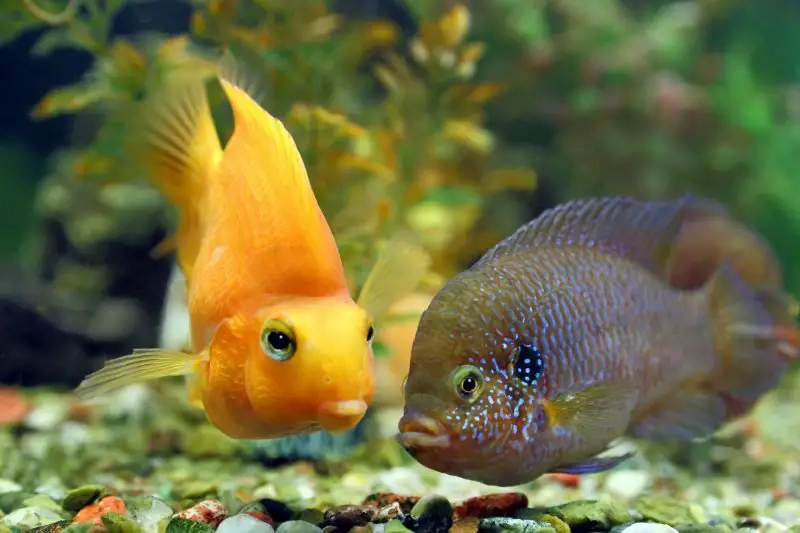
Jewel cichlids are aggressive fish that often pick fights to defend their territories. Don’t house these fish with small, slow-moving, or long-finned fish that jewel cichlids are likely to bully or kill.
Suitable tank mates for jewel cichlids are fast-swimming, schooling fish of a similar size, such as:
- Firemouth cichlids
- Tiger barbs
- Clown loaches
- Plecos
- Redtail sharks
Ideally, jewel cichlids should be housed in pairs, with no other tank mates. Even the most confident fish may be bullied or harassed by these cichlids, and you want to avoid conflict in the tank as much as possible.
Jewel Cichlid Diet and Feeding
In the wild, the jewel cichlid eats a diet of invertebrates, small fish, and algae. The fish isn’t a picky eater, so you can feed it a combination of flakes, pellets, algae wafers, blanched vegetables like lettuce leaves, and live foods in captivity.
Provide a variety of foods, including live options (like bloodworms and brine shrimp) twice per week, to ensure all the fish’s nutritional needs are met. Without a varied diet, the fish will lose its vibrant coloring.
Feed a jewel cichlid enough food for the fish to eat within two minutes, then remove the leftovers from the tank. Feed the fish six days a week, allowing one day without food for digestion.
Breeding the Jewel Cichlid
Jewel cichlids are easy to breed in captivity. The fish reach sexual maturity at about six months old.
To breed jewel cichlids in your tank, follow these steps:
- Select a healthy male and female fish and relocate the fish to a separate 30-gallon tank for breeding (if they’re not already housed alone). Separate the fish with a tank divider while you assess their interest in breeding
- Increase the tank’s water temperature to 79–82°F to mimic the temperature rise that prompts mating in the wild
- Wait for the male’s colors to become more vibrant to indicate his desire to mate. During this time, the female should choose a flat rock at the bottom of the tank to lay her eggs
- Remove the tank divider to allow the fish to breed. After mating, the female will lay between 250 and 300 eggs
- Wait for around three days for the eggs to hatch. Both parents will take care of the fry straight away
- After several days, begin feeding the fry small pinches of crushed flakes and mashed pellets, once per day
Should You Get a Jewel Cichlid for Your Aquarium?
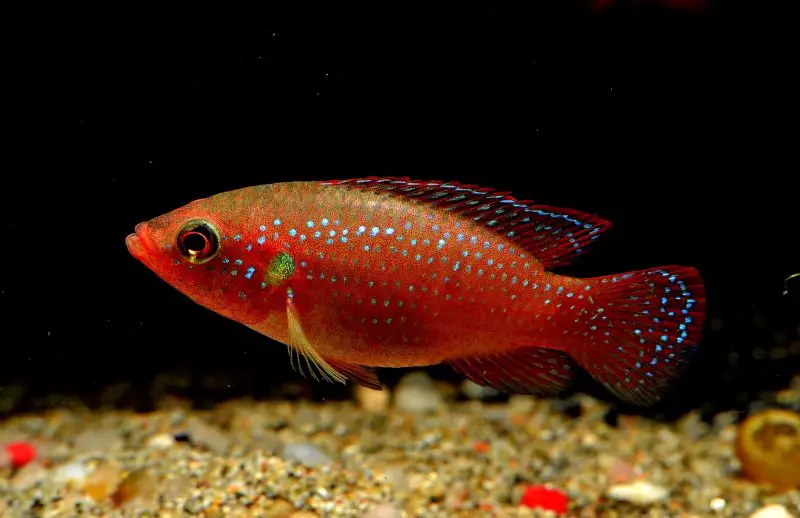
Jewel cichlids are colorful, active fish that are beautiful and fun to watch in an aquarium. You should get a jewel cichlid if you have a spacious tank that you can ideally dedicate to this fish species. Don’t get a jewel cichlid if your tank already contains incompatible fish or is too small for this territorial fish species.
Despite their aggressive tendencies, jewel cichlids are entertaining fish that add a pop of vibrant, shimmering color to an aquarium.
Jewel Cichlid FAQs
Why Do Jewel Cichlids Turn Red?
Jewel cichlids turn red when they’re breeding. The fish’s head and belly become bright red during the breeding season to attract potential mates. You may also notice the fish’s scales on the gill plates and flanks sparkling with shades of blue and green.
Is a Jewel Cichlid Aggressive?
Yes, a jewel cichlid is aggressive due to its territorial nature. Cramped tank conditions, inconsistent feeding or underfeeding, and competition during mating season are common causes of aggression in jewel cichlids. Reduce the fish’s aggressive tendencies by providing plenty of space to claim its own territory and offering enough food for the fish to eat.
Can Jewel Cichlids Live Alone?
Yes, jewel cichlids can live alone in theory, but the fish may become stressed or more aggressive than normal if housed in a tank with no other fish. Ideally, house your jewel cichlids in pairs to keep the fish happy and healthy. Make sure there’s enough space in the tank for two fish — two jewel cichlids should be housed in a minimum 40-gallon tank.
Are Jewel Cichlids Fin Nippers?
Yes, jewel cichlids are fin nippers. The fish are especially likely to nip the fins of fish that are slow-moving and have long, flowing fins. An aggravated or hungry jewel cichlid is most prone to fin nipping. Don’t house the fish with tank mates that have long fins, like guppies, fancy goldfish, and bettas.
Are Jewel Cichlids Hardy?
Yes, jewel cichlids are hardy fish that rarely get sick in captivity. However, the fish may still contract common freshwater diseases, such as ICH and Malawi bloat, especially if the water parameters are wrong or tank cleanliness isn’t maintained. Reduce the risk of disease in your fish by maintaining consistent water parameters and investing in a high-quality filter.
How Fast Do Jewel Cichlids Grow?
Jewel cichlids are fast-growing fish. Newborn jewel cichlids grow to about 0.4 inches within one month. On average, it takes about two years for adults to reach their full size. Factors affecting the fish’s growth rate include tank size, water temperature and quality, and quality and variation of the fish’s diet.

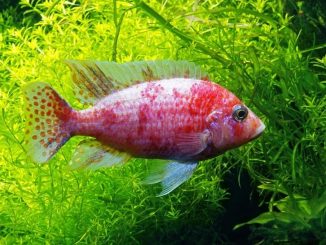
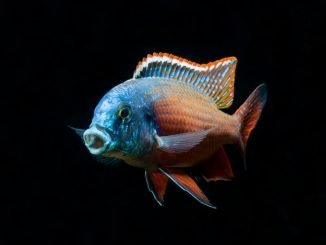
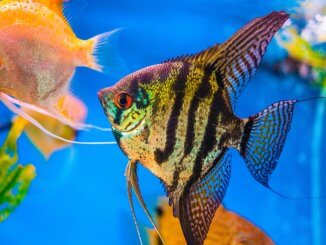
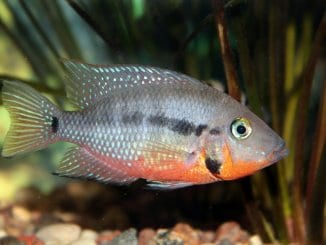
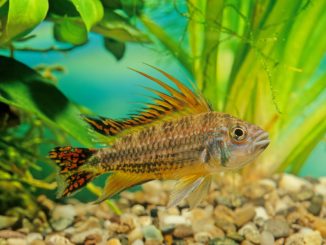
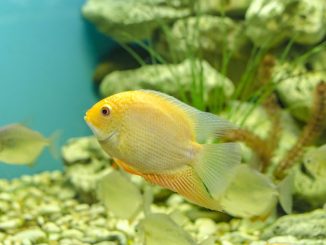
Excellent advice on Jewel cichlid care guide & species profile & help with my breeding pair but I have a question, Do I leave a dim light on for the breeding pair when the eggs are 2 days old because they are moving them to a dark place.
Hello
I’m Thomas and have been doing aquarium’s for about 6 years now. I have a 55 wide, 90 and 120. I’ve had my jeweled since a baby and raised in a community with semi agessive to calm tank mates. Well I adopted a blood parrot cichlid and believe it or not the two paired up as a couple. I’ve since moved them from my 120 gallon to a 90. Their tank mates are 5 male guppies, a fiskis catfish and many cone snailes. It’s amazing to watch the jeweled and blood parrot associate. The blood parrot is the “Boss” and the jeweled is very passive and has been all it’s residency here, I believe 4 year’s. I’ve had the blood parrot 3. Both are very healthy. The blood parrot has been doing nesting gestures since before I moved the pair to the 90. Well today I found eggs in the area where the blood parrot has been doing the nesting gestures. I’m amazed. They’ve been in the 90 for the last 6 months, and are very protective of the tank in general. Everyone gets along great, actually don’t even bother each other. I thought I’d share with you folks my experience with a jeweled cichlid.
I have successfully raised a tiger Oscar and a jewel together in a 55 gallon tank. Had them for a year now. Introduced them at the same time.. it’s funny sometimes knowing the Oscar could swallow him whole, but the jewel will stand his ground and chase the Oscar out of his space. The cohabitate very well together
I have a male turquoise jewel cichlid his wife will be a beautiful female blue salvini cichlid.😊😊😊😊😊😊😊